on the side of the box you can see a small space. insert a small screwdriver.How can the item be opened without destroying it?
I opened/closed mine several times already.
Thanks.
But I cannot see this. The only space I can see is a kind of a gap under the output socket. This is surely not the space you have ment.
Update:
Now I have managed to open it. I did it the old style, with a knife (or a flat blade) gently, like you open a watch. Thanks anyway.
Great little item, isn't it?
I just got mine an hour ago and it plays wonderful (UAE23 V1.0).
I have not compared it to the other Tenor TE7022 based Dacs I have(Audinst Hud-Mx1, Audinst Mini, No-Name WM8761 Dac) and the other Dacs I have here (pro and non-pro), but that will be interesting.
It can also be built in a otherwise passive preamp or with some extra screening into a PC case perhaps. My pcb is pretty clean, btw.
But I cannot see this. The only space I can see is a kind of a gap under the output socket. This is surely not the space you have ment.
Update:
Now I have managed to open it. I did it the old style, with a knife (or a flat blade) gently, like you open a watch. Thanks anyway.
Great little item, isn't it?
I just got mine an hour ago and it plays wonderful (UAE23 V1.0).
I have not compared it to the other Tenor TE7022 based Dacs I have(Audinst Hud-Mx1, Audinst Mini, No-Name WM8761 Dac) and the other Dacs I have here (pro and non-pro), but that will be interesting.
It can also be built in a otherwise passive preamp or with some extra screening into a PC case perhaps. My pcb is pretty clean, btw.
maybe I created the "space" the first time I openend itThanks.
The only space I can see is a kind of a gap under the output socket. This is surely not the space you have ment.
It's indeed a tiny pcb
Maybe I jumped in wrong conclusions but from what I know:
By increasing the sampling bit depth, quantization noise is reduced so that the S/N is improved. The 'rule-of-thumb' relationship between bit depth and S/N is, for each 1-bit increase in bit depth, the S/N will increase by 6 dB.
24-bit digital audio has a theoretical maximum S/N of 144 dB, but digital audio converter technology is limited to a lower S/N
Anyway I think that 16 bit is good for everybody...especially if you pay it 40 euros
By increasing the sampling bit depth, quantization noise is reduced so that the S/N is improved. The 'rule-of-thumb' relationship between bit depth and S/N is, for each 1-bit increase in bit depth, the S/N will increase by 6 dB.
24-bit digital audio has a theoretical maximum S/N of 144 dB, but digital audio converter technology is limited to a lower S/N
Your measurements say that the hifimediy has a Dynamic range of 98 db, so "effective" resolution is quite same (98/6=16,3 bit ) as the fiio 10 that has a dynamic range of 97db...check this link NwAvGuy: FiiO E10 DACDYNAMIC RANGE: A DAC’s noise floor impacts Dynamic Range (DNR), audible noise, THD+N, and can even exceed jitter-induced distortion. If you have to pick a single number to evaluate real world DAC performance –60 dBFS dynamic range (DNR) is one of the most revealing. The guys in the white lab coats have determined DNR greater than 100 dB results in transparency under realistic conditions. And, if you want to adjust the volume in software, it’s best to have at least 110 dB DNR to keep the noise floor inaudible even if the downstream gain is left cranked way up. Anything beyond 110 dB is past the point of diminishing returns—it looks nice on paper but doesn’t help the sound quality. The ODAC is a very substantial 14 dB better than the FiiO E10.
Anyway I think that 16 bit is good for everybody...especially if you pay it 40 euros
Last edited:
I immediately tried the kernel drivers with foobar (24bit resolution) and it works without a flaw. I am not sure if the volume control reduces the output via resolution (should actually not happen with kernel drivers) or the the volume control (either via Win7 or with foobar itself) is controlling the analog output of the Dac (as Hifimediy proposed), which would be perfect.
Win7 installs a Sabre 24/96 driver by itself during the first plugin/powerup with the item - I do not know if you mean that this is the extra Sabre driver?
Win7 installs a Sabre 24/96 driver by itself during the first plugin/powerup with the item - I do not know if you mean that this is the extra Sabre driver?
I am not sure if the volume control reduces the output via resolution (should actually not happen with kernel drivers)
It always happens when you use a software volume control.
@azimut : I don't think the lower DNR should be considered as lower "effective" resolution. It has to do with the noise floor. The two chips manage 24bits signal. In a player supporting 24 bits, there is 48dB (144-96) available for digital volume control attenuation without any signal degradation. Above that, signal is degraded (1bit lost per 6dB attenuation).
ODAC's design calls for lower noise floor. It achieves 111dB DNR, ie almost the chip's DNR of 112dB. Hifimediy's dac version 2, with improved voltage regulator, has probably a better DNR and SNR than mine. Close to 100dB is excellent IMHO. 10 years ago this was only available in high end devices
Also consider that my measurement setup and hardware are for sure not equivalent to nwavguy's lab equipment
BTW, I use analog volume control
ODAC's design calls for lower noise floor. It achieves 111dB DNR, ie almost the chip's DNR of 112dB. Hifimediy's dac version 2, with improved voltage regulator, has probably a better DNR and SNR than mine. Close to 100dB is excellent IMHO. 10 years ago this was only available in high end devices
Also consider that my measurement setup and hardware are for sure not equivalent to nwavguy's lab equipment
BTW, I use analog volume control
Looking closely to the ES9023 dac chip datasheet it is clear to me now that there is no inbuildt hardware volume control (except by an outside resistance). That reduces the usability of the HifiMeDiy Sabre USB DAC as a headphone output quite a bit. As a normal line output device it is nevertheless "formidable" or "Buonissimo!" - especially considering the price...
Just received the DAC - impressed for the price!
I just received my little package from China. I'm very impressed for the price and tiny size, IMHO. The sound is subjectively miles ahead of the built-in DAC in a Sony laptop.
I'm very impressed for the price and tiny size, IMHO. The sound is subjectively miles ahead of the built-in DAC in a Sony laptop.
Here are some photos and measurements for fun:
The first picture shows the tiny size of the DAC vs. a US quarter, a pair of AKG K550 headphones, and a PC mouse. Small!
The next two pictures show the DC offset on the two channels. 405uV and -264uV. Those tiny levels are fantastic.
Next are the AC volts rms values over the course of playing a song on the PC, max - avg - min. The AKG K550 headphones are being powered directly by the DAC here. The PC volume slider is at about half way, 48/100, which results in normal listening levels on the K550s. The range goes from about 8mV rms (min) to 57mV rms (max). The PC slider in the photo isn't clear. That blue glob at the top isn't the slider, that is an icon. Look hard right at the middle of the slider range and you will see the slider "handle".
The next 3 photos are a dB/V plot during a frequency sweep from 20Hz to 15kHz on the PC, along with photos of two of the data points during the sweep. The X axis on the plot is NOT frequency here but rather time, set up for a 1 second sampling recording, while I turned the sweep file on and off on the PC. So this plot is useless for looking at low and high end frequency rolloff, rather just roughly what happens in the middle. Which is pretty flat!
The next 3 photos are scope shots at 50Hz, 250Hz, and 15Khz from sine wave files on the PC. The scope probe is 10x (32mV DAC output, the 320mV shown on the scope screen divided by 10) and the time base is adjusted as it went to just show a few cycles on the screen. Vertical volts/div remains constant on all.
I just received my little package from China.
Here are some photos and measurements for fun:
The first picture shows the tiny size of the DAC vs. a US quarter, a pair of AKG K550 headphones, and a PC mouse. Small!
The next two pictures show the DC offset on the two channels. 405uV and -264uV. Those tiny levels are fantastic.
Next are the AC volts rms values over the course of playing a song on the PC, max - avg - min. The AKG K550 headphones are being powered directly by the DAC here. The PC volume slider is at about half way, 48/100, which results in normal listening levels on the K550s. The range goes from about 8mV rms (min) to 57mV rms (max). The PC slider in the photo isn't clear. That blue glob at the top isn't the slider, that is an icon. Look hard right at the middle of the slider range and you will see the slider "handle".
The next 3 photos are a dB/V plot during a frequency sweep from 20Hz to 15kHz on the PC, along with photos of two of the data points during the sweep. The X axis on the plot is NOT frequency here but rather time, set up for a 1 second sampling recording, while I turned the sweep file on and off on the PC. So this plot is useless for looking at low and high end frequency rolloff, rather just roughly what happens in the middle. Which is pretty flat!
The next 3 photos are scope shots at 50Hz, 250Hz, and 15Khz from sine wave files on the PC. The scope probe is 10x (32mV DAC output, the 320mV shown on the scope screen divided by 10) and the time base is adjusted as it went to just show a few cycles on the screen. Vertical volts/div remains constant on all.
Attachments
-
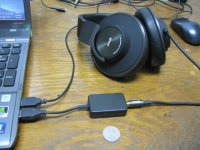 IMG_1627.JPG193.8 KB · Views: 1,526
IMG_1627.JPG193.8 KB · Views: 1,526 -
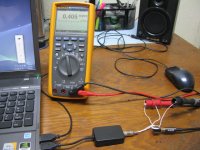 IMG_1610.JPG211.3 KB · Views: 1,434
IMG_1610.JPG211.3 KB · Views: 1,434 -
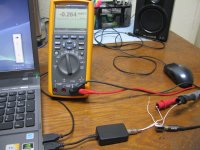 IMG_1611.JPG210.5 KB · Views: 1,394
IMG_1611.JPG210.5 KB · Views: 1,394 -
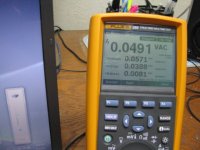 IMG_1612.JPG162.4 KB · Views: 1,377
IMG_1612.JPG162.4 KB · Views: 1,377 -
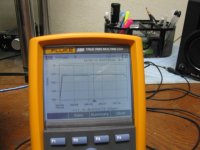 IMG_1617.JPG162.7 KB · Views: 1,352
IMG_1617.JPG162.7 KB · Views: 1,352 -
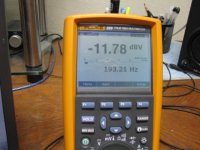 IMG_1618.JPG168.8 KB · Views: 175
IMG_1618.JPG168.8 KB · Views: 175 -
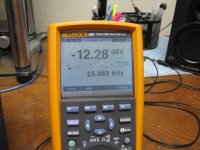 IMG_1620.JPG177.7 KB · Views: 135
IMG_1620.JPG177.7 KB · Views: 135 -
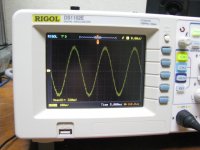 IMG_1622.JPG154.1 KB · Views: 206
IMG_1622.JPG154.1 KB · Views: 206 -
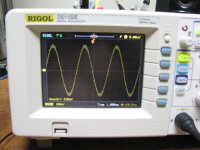 IMG_1623.JPG149.6 KB · Views: 211
IMG_1623.JPG149.6 KB · Views: 211 -
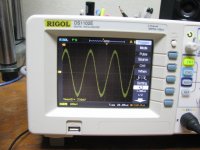 IMG_1626.JPG164.4 KB · Views: 182
IMG_1626.JPG164.4 KB · Views: 182
Last edited:
Hmmm.... one correction to my post above, after listening some more and checking settings. The HiFimeDIY DAC loaded up with the"Sabre 24/96" drivers on my Win 7 Pro installation, too, as other posts have noted. I had the HiFimeDIY DAC set at 24/44.1kHz. I just noticed that the laptop, which also has a 24/96 DAC, was set to 16/44.1 at the moment.
Changing that on-board laptop DAC to 24/44.1, and doing more of a proper A/B, I really don't hear any difference at all anymore. Not miles ahead. I probably wouldn't have even heard a difference before if it were not for the software volume slider needing to be down halfway to power the AGK K550s directly from the external DAC (loosing software bits) vs. 3/4 of the way up for the built in DAC and amp.
This isn't saying anything bad about the HiFimeDIY, but rather probably something good about the on-board sound in the Sony. Both will run at 24/44.1 and 24/96. Probably also says something about how useless subjective listening tests are! lol.
Changing that on-board laptop DAC to 24/44.1, and doing more of a proper A/B, I really don't hear any difference at all anymore. Not miles ahead. I probably wouldn't have even heard a difference before if it were not for the software volume slider needing to be down halfway to power the AGK K550s directly from the external DAC (loosing software bits) vs. 3/4 of the way up for the built in DAC and amp.
This isn't saying anything bad about the HiFimeDIY, but rather probably something good about the on-board sound in the Sony. Both will run at 24/44.1 and 24/96. Probably also says something about how useless subjective listening tests are! lol.
Last edited:
Comparison with V-Link & CS4398 system
I've been using a Musical Fidelity V-Link (asynch) USB to s/pdif converter with toslink connection to a CS4398 dac with passive Tamura output transformers for PC playback for a while. The system is very nice and clean but errs on the side of smooth and silky.
My laptop has a knackered battery so runs from the SMPS charger continuously. Prior the the battery dying it was very obvious that the noise floor of the laptop was much much higher with the charger connected. The toslink connection between USB digital interface and dac dealt was the only viable solution, as any ground connection between laptop and stereo destroyed the sound quality.
I initially connected the ES9023+TE7022 between the laptop and amp. The sound had promise but the noise floor was very high and there was a noticeable harshness to the sound. Pretty much what I would have expected given my previous experiences of ground connections from laptop to stereo.
To isolate the laptop from my playback kit, I introduced a cheap ebay ADUM4160 USB isolator (USB protection /ADUM4160 Evaluation Board /USB Isolator | eBay) and separate linear DC supply connected to the relatively clean mains supply used for my playback kit. This entirely dealt with the noise issue and removed the harshness I'd experienced previously. All sounding very nice with more dynamics and deeper, better defined bass than my usual USB interface and dac. Probably not quite the same silky smoothness although this is probably just due to the removal of the 'nicely' coloured Tamura transformers.
The next step will be to mount the USB isolator and ES9023+TE7022 dac PC inside a single chassis with external connections for USB in, DC in and line level out.
I'd heartily recommend the USB isolator for this dac.
I've been using a Musical Fidelity V-Link (asynch) USB to s/pdif converter with toslink connection to a CS4398 dac with passive Tamura output transformers for PC playback for a while. The system is very nice and clean but errs on the side of smooth and silky.
My laptop has a knackered battery so runs from the SMPS charger continuously. Prior the the battery dying it was very obvious that the noise floor of the laptop was much much higher with the charger connected. The toslink connection between USB digital interface and dac dealt was the only viable solution, as any ground connection between laptop and stereo destroyed the sound quality.
I initially connected the ES9023+TE7022 between the laptop and amp. The sound had promise but the noise floor was very high and there was a noticeable harshness to the sound. Pretty much what I would have expected given my previous experiences of ground connections from laptop to stereo.
To isolate the laptop from my playback kit, I introduced a cheap ebay ADUM4160 USB isolator (USB protection /ADUM4160 Evaluation Board /USB Isolator | eBay) and separate linear DC supply connected to the relatively clean mains supply used for my playback kit. This entirely dealt with the noise issue and removed the harshness I'd experienced previously. All sounding very nice with more dynamics and deeper, better defined bass than my usual USB interface and dac. Probably not quite the same silky smoothness although this is probably just due to the removal of the 'nicely' coloured Tamura transformers.
The next step will be to mount the USB isolator and ES9023+TE7022 dac PC inside a single chassis with external connections for USB in, DC in and line level out.
I'd heartily recommend the USB isolator for this dac.
I would go with the original design of this pcb:
and cheaper than the Chinese replica in your post
ADuM4160 USB Isolator board, bare PCB and kits « Circuits@Home
also better to feed the adum4160 with its own isloated power.
and cheaper than the Chinese replica in your post
ADuM4160 USB Isolator board, bare PCB and kits « Circuits@Home
also better to feed the adum4160 with its own isloated power.
They have a new model out : Hifimediy Sabre COAX/OPTICAL DAC. ES9023 + CS8416 230V
This time with onboard power supply, coax & optical inputs. Unfortunately, they decided to use CS8416, not higher quality WM8805 as the digital input chip.
This time with onboard power supply, coax & optical inputs. Unfortunately, they decided to use CS8416, not higher quality WM8805 as the digital input chip.
It's not a bad choice. CS8416 is 24/192 in hardware mode. wm8805 is limited to 24/96.they decided to use CS8416, not higher quality WM8805 as the digital input chip.
wm8805 has supposely better jitter, but WM does not measure jitter the same way. Where is the truth ? Frankly speaking, i doubt any one can hear or even measure the receiver difference.
IMHO, the dac chip is far more important than the receiver. The Sabre ES9023 is an impressive dac
It's not a bad choice. CS8416 is 24/192 in hardware mode. wm8805 is limited to 24/96.
wm8805 has supposely better jitter, but WM does not measure jitter the same way. Where is the truth ? Frankly speaking, i doubt any one can hear or even measure the receiver difference.
IMHO, the dac chip is far more important than the receiver. The Sabre ES9023 is an impressive dac
I just don't understand why they choose CS8416 while they use WM8805 for the CS4398 DAC ( which I have & c'est pas mal du tout) and new version of DDX320 amp (which they mention as upgrade from CS8416 on the previous problematic version).
But are you sure that WM8805 only accept 24/96 as hifimediy mention that their CS4398 direct DAC supports up to 24/192 ? That thing uses WM8805.
Merci bcp
- Status
- This old topic is closed. If you want to reopen this topic, contact a moderator using the "Report Post" button.
- Home
- Source & Line
- Digital Line Level
- Hifimediy ES9023+TE7022 24/96 USB Dac
